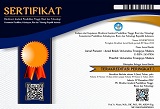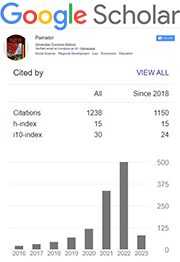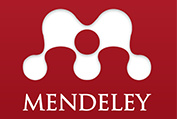The Use of Collective Intelligence to Create Efficient Marketing Strategies
Abstract
There is no doubt that almost all companies recognized the necessity and the significant role of marketing strategies in the development and the progress of any business. However, the challenge still is how to elaborate and create effective marketing strategies? The purpose of this study is to investigate and illustrate how we could create efficient marketing strategies by using the Collective Intelligence approach? Interviews were conducted with marketing department teams; added to participants from other department members and also customers and stakeholders. through three different steps (before, during, and after the use of this approach); in order to provide and discover the feedbacks and results of all participants through the implementation of the Collective Intelligence approach. Following the result; There is a consensus from the participants of this research study confirmed that the use of this new concept of collective intelligence will not only transform the design of the future trajectory of elaboration of marketing strategies but also the future of work.
Keywords
Full Text:
PDFReferences
Aggarwal, I., Woolley, A.W. 2018. Team Creativity, Cognition, and Cognitive Style Diversity. Journal Management Science. 1–14 pp.
Anita, W., Alex, P., Christopher, F.C & Nada, H. 2010. Evidence of a Collective Intelligence Factor in the Performance of Human Groups, Science.
Anita, W. A., Thomas, W. 2015. Collective Intelligence and Group Performance. Curr. Dir. Psychol Sage Journals. Sci. Vol 24 (6). 420–424 pp.
Ataman, M. B., Van Heerde, H. J., & Mela, C. F. 2010. The Long-Term Effect of Marketing Strategy on Brand Sales. Journal of Marketing Research. Vol 47(5), 866–882 pp.
Atuahene-Gima, K., & Murray, J. Y. 2004. Antecedents and Outcomes of Marketing Strategy Comprehensiveness. Journal of Marketing. Vol 68(4). 33–46 pp.
Benson S. 2002. Want a Happy Customer? Coordinate Sales and Marketing Harvard, Business School Working Knowledge.
Buzzell, R. D., & Gale, B. T. 1987. The PIMS Principles: Linking Strategy to Performance. New York: The Free Press.
Chang, J.W., Chow, R.C., & Woolley, A.W. 2017. Effects of Inter-Group Status on The Pursuit of Intra-Group Status. Organizational Behavior and Human Decision Processes. Vol 139. 1-17 pp.
Carola, G. Maike, B. 2011. A Way to More Effective Marketing Strategies: Analyzing Dimensionality of Cognitive Structures Quantitatively. Sage journals.
Chikersal, P. Maria, T. Young JK. 2017. Deep Structures of Collaboration: Physiological Correlates of Collective Intelligence and Group Satisfaction. Proceedings of the 20th ACM Conference on Computer-Supported Cooperative Work and Social Computing- CSCW 2017.
Dau, L.A. 2018. Contextualizing International Learning: The Moderating Effects of Mode of Entry and Subsidiary Networks on The Relationship Between Reforms And Profitability. Journal of World Business. Vol. 53 (3). 403-414 pp.
Engel, D., Woolley, A. W., Aggarwal, I., Chabris, C. F., Malone, T. W. 2015. Collective intelligence in online collaboration emerges in different contexts and cultures. In Proceedings of the 33rd Annual ACM Conference on Human Factors in Computing Systems (CHI ’15) (pp. 3769–3778).
Goldstone, R & Janssen, M. 2005. Computational Models of Collective Behavior. Trends in Cognitive Science. Vol 9. 424-430 pp.
Jager, W. Delre, S. Janssen, M (2007). Targeting and Timing Promotional Activities: An Agent-Based Model for the Takeoff of New Products. Journal of Business Research. Vol 60 (8). 826- 835 pp.
McGrath, J.E. 1984. Groups: Interaction and Performance. Prentice-Hall, Englewood Cliffs, NJ. 287 pages.
John, M., Orville W., J.C Larreche. 2004. Marketing Management: A Strategic Decision-Making Approach. McGraw-Hill/Irwin; 5-edition.
Jordan, R. Audrey, G. Paula, D. 2011. The Marketing Concept in The 21st Century: A Review of How Marketing Has Been Defined Since The 1960s. The Marketing Review.
Hackman, J.R 2002. Leading Teams: Setting the Stage for Great Performances. Harvard Business Press, Boston. 312 pages.
Kim, Y. J., Engel, D., Woolley, A., Lin, J., McArthur, N., & Malone, T. 2017. What Makes A Strong Team? Using Collective Intelligence To Predict Performance Of Teams In League Of Legends. Proceedings of the 20th ACM Conference on Computer-Supported Cooperative Work and Social Computing (CSCW 2017).
Malone, T.W., Laubacher, R., Dellarocas, C., 2010. The Collective Intelligence Genome. MIT Sloan Manag. Rev. 51 (3), 21.
Morgan, N. A., Whitler, K. A., Feng, H., & Chari, S. 2019. Research in Marketing Strategy. Journal of the Academy of Marketing Science. Vol 47(1). 4–29 pp.
Palmatier, R. W., & Sridhar, S. 2017. Marketing Strategy: Based on First Principles and Data Analytics. Macmillan International Higher Education.
Rajan, V. 2010. Strategic Marketing and Marketing Strategy: Domain, Definition, Fundamental Issues and Foundational Premises. Journal of the Academy of Marketing Science. Vol 38(2). 119-140 pp.
Reibstein, D. J., Day, G., & Wind, J. Guest. 2009. Is Marketing Losing Its Way?. Journal of Marketing. Vol 73. 1–3 pp.
Slater, S. F., Hult, G. T. M., & Olson, E. M. 2010. Factors Influencing The Relative Importance of Marketing Strategy Creativity and Marketing Strategy Implementation Effectiveness. Industrial Marketing Management. Vol 39 (4). 551–559 pp.
Solomon, M., Greg, W. 2008. Marketing: Real People, Real Choices. Prentice Hall, New Jersey. Pearson; 9edition.
Tilmann, B. 2010. Marketing Intelligent Systems Using Soft Computing - Collective Intelligence in Marketing Chapter. Springer, Berlin, Heidelberg, pp 131-154.
Walker, O. John, M. 2008. Marketing Strategy: A Decision Focused Approach, MacGraw-Hill, New York. 8th Edition- 364 pages.
Woolley, A.W., Fuchs, E.,. 2011. Collective Intelligence in The Organization of Science. Organ. Sci. 22 (5), 1359–1367.
Woolley, A.W. 2011. Responses to Adversarial Situations The Implications for Collective Intelligence. Journal of Organizational Behavior. Vol 32. 978-983 pp.
DOI: https://doi.org/10.21107/pamator.v13i2.7326
Refbacks
- There are currently no refbacks.
Copyright (c) 2020

This work is licensed under a Creative Commons Attribution-ShareAlike 4.0 International License.
Jurnal Pamator : Jurnal Ilmiah Universitas Trunojoyo by Universitas Trunojoyo Madura is licensed under a Creative Commons Attribution-ShareAlike 4.0 International License.















.png)